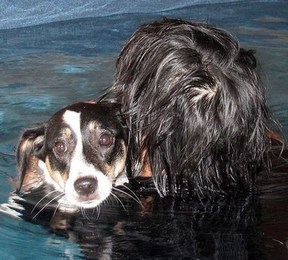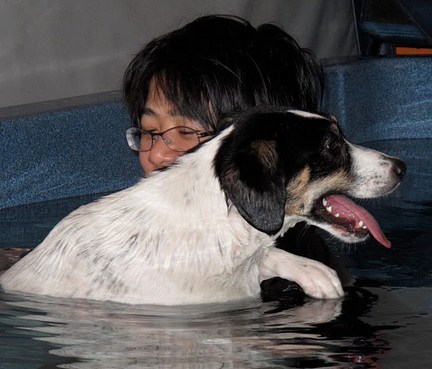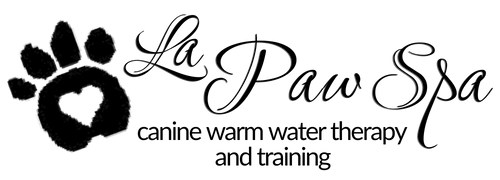I’m amazed by how much I learn in a dog-training seminar that directly applies to canine aquatic fitness and canine massage. When I was first starting out, an industry insider told me that I had to make a choice: dog training or holistic therapy. I’m now glad that I didn’t make that choice – dog training knowledge can definitely enhance my water practitioner skills.
Recently, I attended the Association of Pet Dog Trainers conference, where an entire day was dedicated to expert behaviorists talking about fear. While watching videos that showed how a dog communicates fear I realized, “I can definitely apply this information to my work!”
I found that it is about awareness and knowing the signs of fear to look for, and then helping the dog come back from being scared. For example, if I observe that a dog’s body, eyes and/or ears are showing fear, I can reflect back to the dog some calming signals – these are signals that dogs use to communicate appeasement or “don’t be scared of me” to each other. These signals are subtle, such as a look away, turn my body slightly away from the dog, or even yawn or lick my lips. And, I may continue to convey my intention that “You am safe, I am here for your greater good.”
Most dogs experience some amount of anxiety when they are first introduced to the pool. I find it very important to know what fear looks like and how to handle it. Below I list some typical behaviors of frightened dogs (an “ethology”) and some pictures of Sophie, who is described as a generally fearful dog who recently came for her first swim. I’ve also noted some areas where I might change my approach after observing this behavior.
Body
Freeze — “When the dog ceases all movement for a brief moment. A freeze includes a tensing up of the muscles.” (2)
I’ve noticed that a dog might freeze when first introduced to the water. I often stop and do some light massage while letting the dog return from that point of fear. If I’m hovering over the dog in order to get her into the pool, I might also move off to a less imposing position. I normally consider it a success when the dog starts looking around or looking at the water.
Eyes
Dilated Eye — Where the pupil is large, almost to the point of the iris not being visible. “Dogs’ eyes dilate from low light and from any situation that triggers sympathetic stimulation, whether it be eustress or distress.” (1)
Hard Eye — “When the dog’s eyes are open, round, with the tapetum visible. The tapetum is the reflective layer of the choroid of the eye, which gives the hard eye its characteristic marble-like, glowing quality. The brow is usually, but not always furrowed/tense.” (2)
Whale Eye — “When the whites of the dog’s eye shows. The dog’s head moves slightly ahead of the eyeball, causing the corner to show white.” (2)
When I see signs of fear in the eyes, then I can slow down the session, talk in soothing tones, and continue massage – as opposed to moving on to a first swim or something else. I can also send calming signals by keeping my head slightly averted or not staring at her face.
Mouth
Clenched Jaw – One of the “freeze” signals, where the dog is clenching his jaw shut as an avoidance mechanism to movement.
Lips — Short lips might indicate tenseness (with a closed mouth). If the dog looks at me, I might try other calming signals like licking my lips and yawning.
Wide Panting — “When the dog’s mouth is parted extra wide, without having his lips
retracted while he breathes with his mouth open.”(2)
Panting can be indicative of many things: over-exertion, relaxation, and also fear. I try to interpret the panting and not merely assume that it’s happy panting. But generally it’s a good sign to have a dog that is panting rather than clenching her jaw.
Ears
Flattened Back Ears — “Dogs who are frightened may flatten their ears against the sides of their heads.” (1)
Pinched Ears — “Pinch ear is only visible in floppy eared dogs – Labs, Goldens, hounds, etc. They turn the ear parallel to the side of the face and pull it towards the skull. Pinch ears occur during times when the dog is extremely stressed or fearful.” (1)
In a typical water position, I usually can see the ears more easily than the eyes – but the challenge is that there are so many different ear sets. Often I consult with the guardian and ask, “Does your dog typically hold her ears back like this when she’s scared?” If so, I might rub the ears to activate their acupressure points – or continue with other calming signals.
—
In conclusion, working with water, massage, and bodywork–along with awareness of a dog’s fear signals and the application of calming responses– leads to a happy dog who can move beyond her fear.
References:
(1) Handelman M.Ed, CDBC, Barbara. Canine Behavior A Photo Illustrated
Handbook 2008, Dogwise:
(2) Sternberg, Sue. Website http://www.suesternberg.com/
About the Author: Cathy Chen-Rennie opened The Rex Center, a comprehensive holistic behavioral and physical wellness facility in Pacifica, to provide canine warm-water swimming, dog training, and holistic therapies such as reiki and massage to SF/Bay Area pets. cathy@therexcenter.com

Figure 1: Sophie exhibiting a whale eye

Figure 2: Sophie is initially scared in the water – not the large hard eyes and ears are pulled back/pinched.

Figure 3: Sophie relaxes after a couple of swims and a lot of time. She stops clenching her jaw, pants gently and her ears go back to normal. It could be argued that she’s stress panting, except that her eyes were soft, and ears were not pinned b
